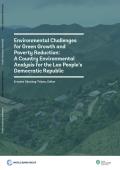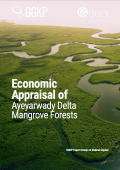This case study assesses where and how ecosystems in Myanmar provide key benefits to the country’s people and infrastructure. It models the supply of and demand for sediment retention, dry season baseflows, flood risk reduction, and coastal storm protection from multiple beneficiaries. By highlighting areas where loss of natural ecosystems would have outsized negative consequences for Myanmar’s people and infrastructure, the national assessment serves as a guide for land use planning for agricultural expansion and resettlement plans, as well as informs the location and design of infrastructure projects such as roads, transmission lines, canals, and hydropower and other energy projects.
The findings suggest that locations currently providing the greatest amount of ecosystem services are likely to remain important under the range of climate conditions considered, demonstrating their importance in planning for climate resilience. It also finds that while overlap between priority areas for ecosystem service provision and biodiversity conservation is higher than expected by chance, the areas important for multiple ecosystem services are underrepresented in currently designated protected areas and key biodiversity areas.
These results are already contributing to national land use, development, and climate adaptation planning, policy making, and decision making in Myanmar. However, going forward, the study has also identified several additional recommendations for improving the integration of natural capital and ecosystem services assessments in national processes, including:
- Accounting for specificities in regional demand. Achieving equitable, inclusive development requires consideration of how the value or importance of ecosystem services from a given area varies among beneficiary groups. For example, for the dry season baseflow whose demand is driven by households relying on surface water, the study did not account for current or future regional water scarcity.
- Integrating climate change projections into ecosystem services assessments. The current decade has seen growing attention on the impacts of climate change on ecosystems. In particular, future assessments would benefit from: (i) assessing the impacts of climate change on ecosystem services through changes in vegetation and land management; (ii) accounting for the impacts of extreme weather events on natural capital and ecosystem services; (iii) enhancing baseline data to strengthen projections; and (iv) improving accounting for and communication of uncertainty.
- Balancing the trade-offs among analysis complexity, knowledge ownership by stakeholders, and decision-making relevance. While more sophisticated models provide a more precise characterization of the effects of climate change on natural capital and ecosystem service provision, this inherently increases data requirements and analytical complexity. Balancing these trade-offs can be difficult, and requires consideration of the ultimate aims, such as informing a specific policy or decision. However, the study illustrates that, even under conditions of limited data and rapid timelines, it is possible to produce initial, policy-relevant assessments that can set the stage for decision-making.




